Abstract
We determined whether epitope-specific monoclonal antibodies to the galactose-inhibitable adherence protein (GIAP) of Entamoeba histolytica could be used in an enzyme-linked immunosorbent assay (ELISA) to detect antigen in serum and feces and differentiate between nonpathogenic zymodemes and the potentially invasive pathogenic organisms that require treatment. Overall, 57% of subjects from Cairo, Egypt, with symptomatic intestinal amebiasis and 42% with asymptomatic infection possessed GIAP antigen in their sera, whereas 4% of uninfected controls or subjects with other parasitic infections possessed GIAP antigen in their sera (P < 0.001). In subjects from Durban, South Africa, only 6% of uninfected controls or those with nonpathogenic E. histolytica infection were positive for GIAP in serum, whereas 3 of 4 with asymptomatic pathogenic intestinal infection and 75% with amebic liver abscess were positive for GIAP in serum. Fifteen stool samples from patients with intestinal amebiasis were available for study; all had a positive ELISA result for fecal GIAP antigen. Epitope-specific monoclonal antibodies identified 8 of 15 subjects with fecal antigen from pathogenic strains. Seven of those eight subjects had adherence protein antigen in their sera, whereas none of seven with apparent nonpathogenic E. histolytica infection had adherence protein antigen in their sera. In summary, we were able to detect E. histolytica adherence protein antigen directly in serum and fecal samples by ELISA. The presence of amebic antigen in serum demonstrated 94% specificity for pathogenic E. histolytica infection, and amebic antigen is present during asymptomatic intestinal infection. In conjunction with antibody detection, this method should be very useful in the diagnosis and management of intestinal amebiasis.
Full text
PDF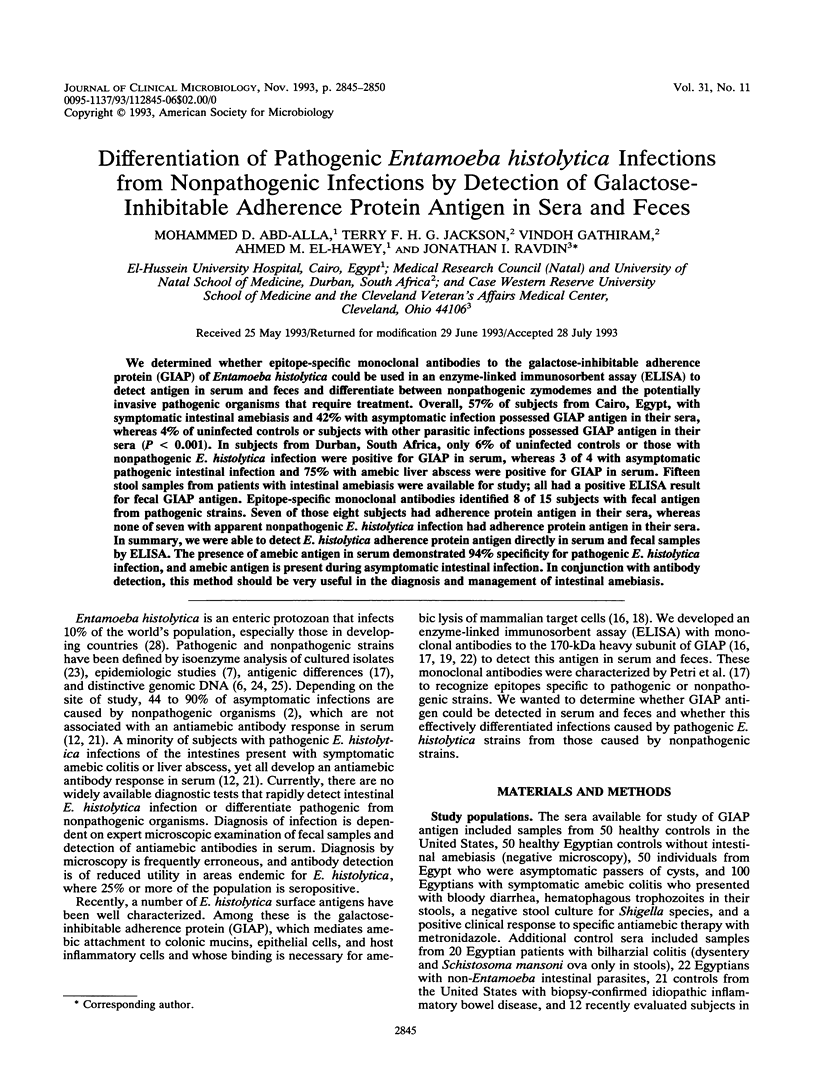
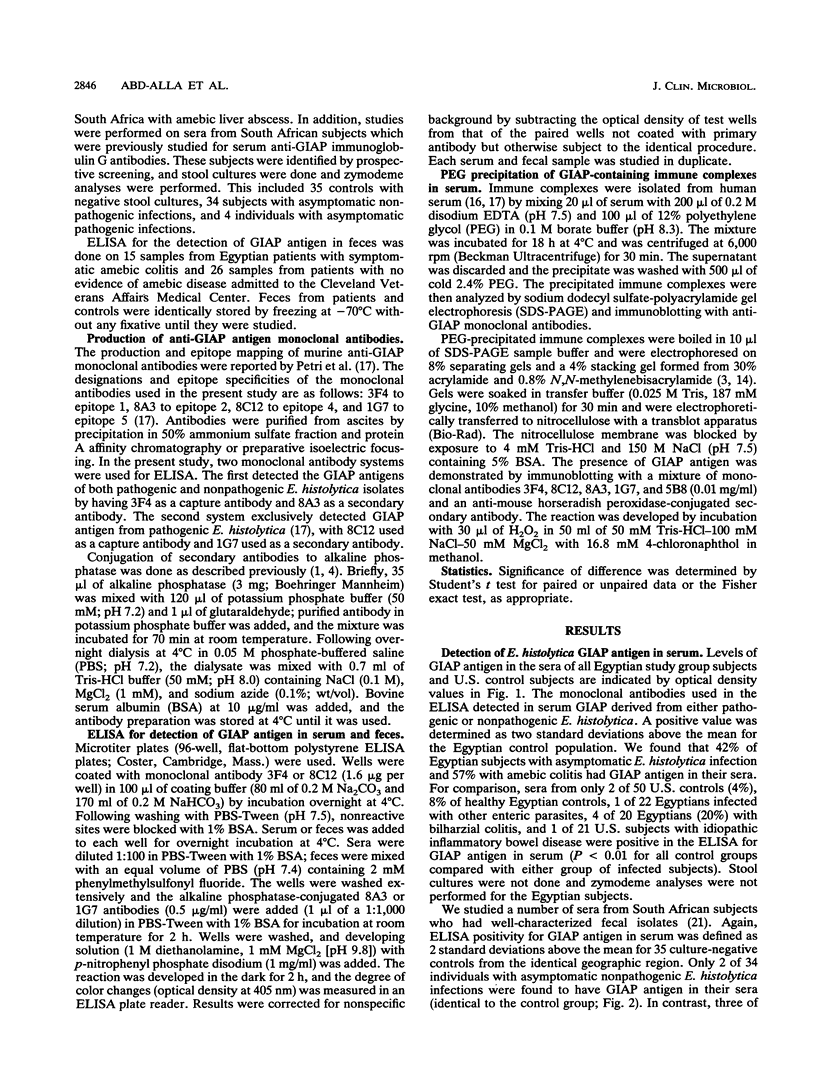
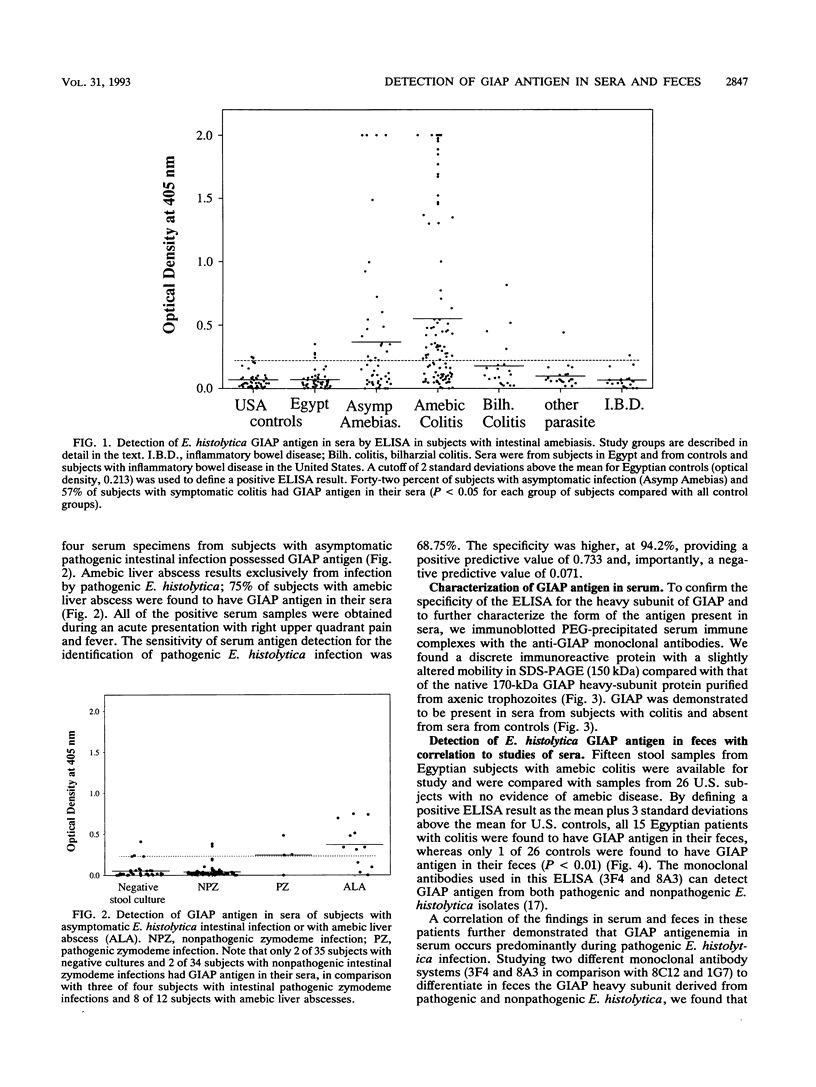
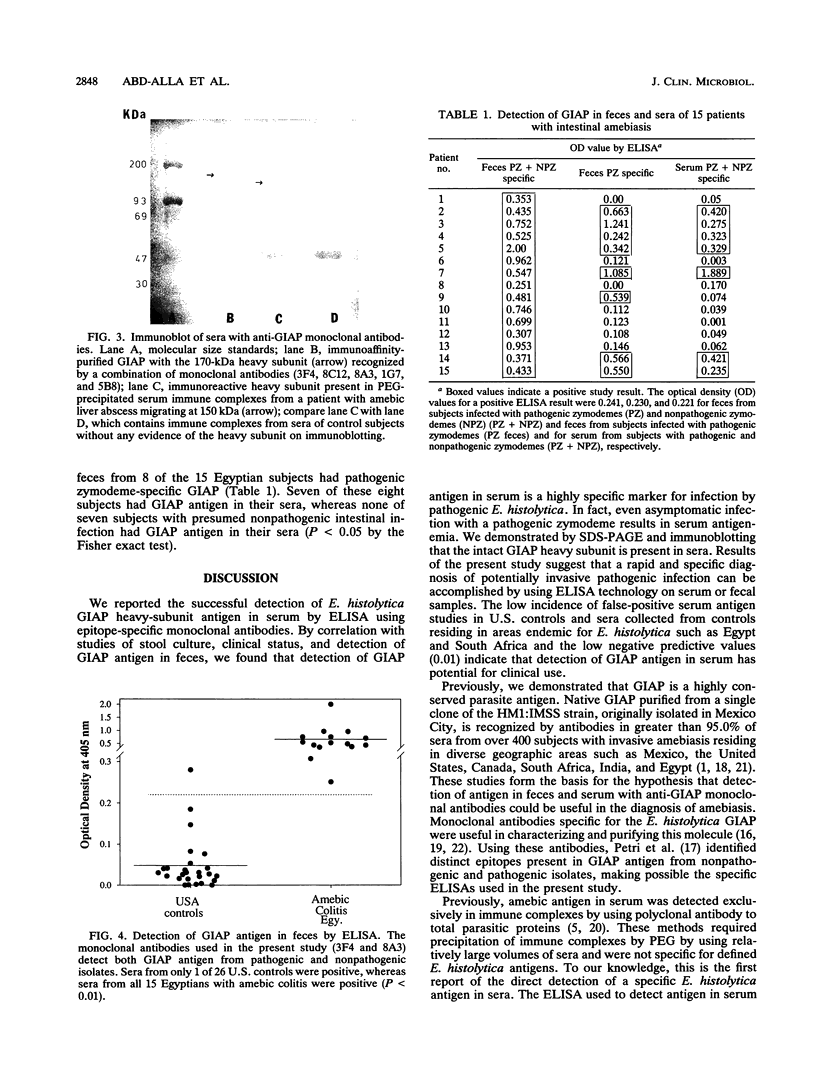
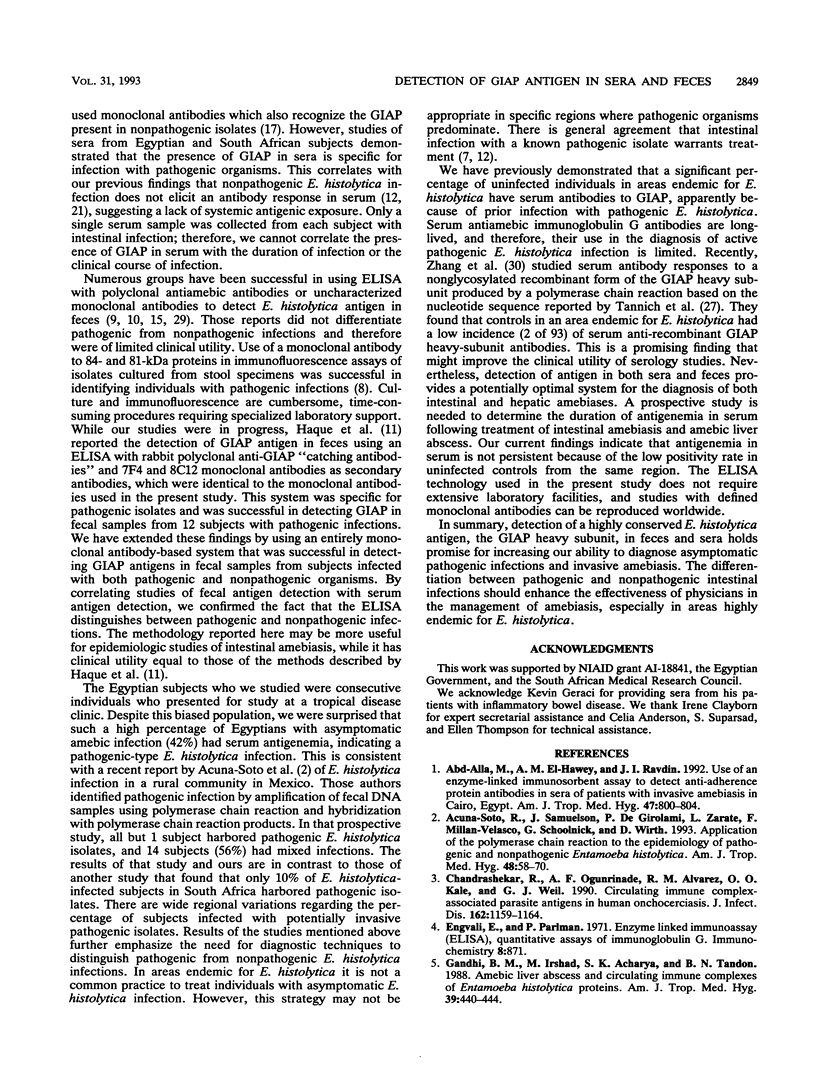
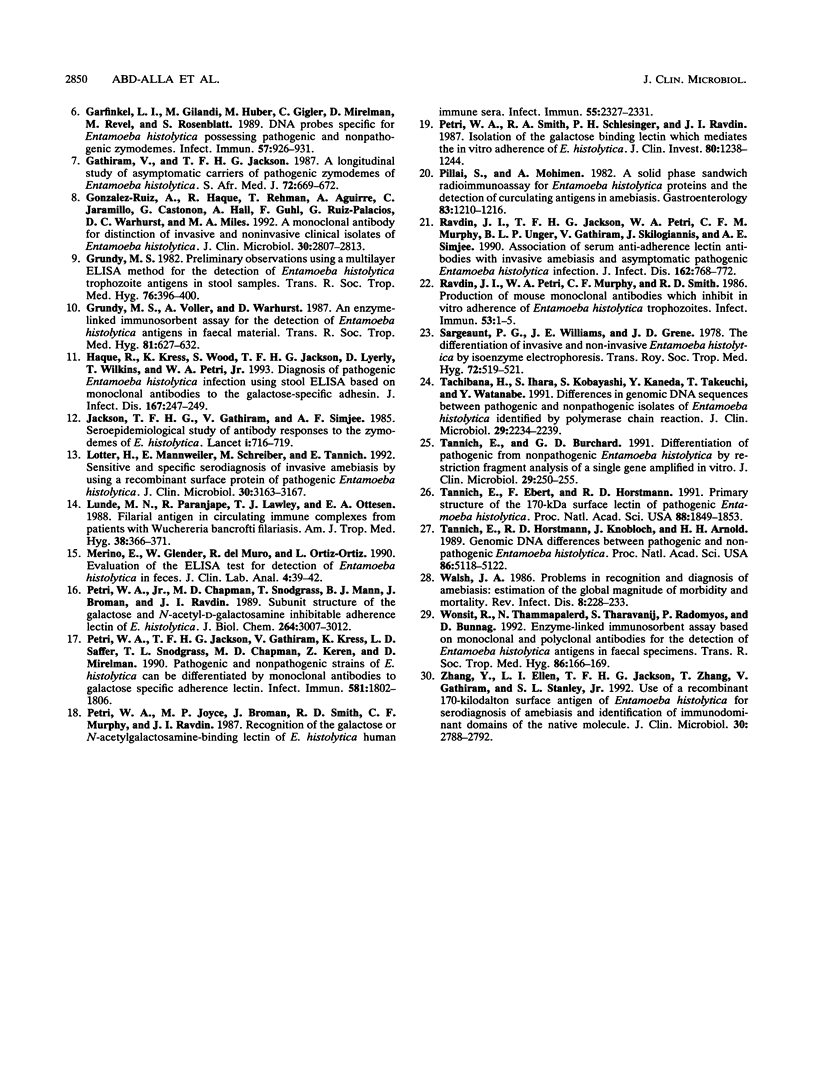
Images in this article
Selected References
These references are in PubMed. This may not be the complete list of references from this article.
- Abd-Alla M. D., el-Hawey A. M., Ravdin J. I. Use of an enzyme-linked immunosorbent assay to detect anti-adherence protein antibodies in sera of patients with invasive amebiasis in Cairo, Egypt. Am J Trop Med Hyg. 1992 Dec;47(6):800–804. doi: 10.4269/ajtmh.1992.47.800. [DOI] [PubMed] [Google Scholar]
- Acuna-Soto R., Samuelson J., De Girolami P., Zarate L., Millan-Velasco F., Schoolnick G., Wirth D. Application of the polymerase chain reaction to the epidemiology of pathogenic and nonpathogenic Entamoeba histolytica. Am J Trop Med Hyg. 1993 Jan;48(1):58–70. doi: 10.4269/ajtmh.1993.48.58. [DOI] [PubMed] [Google Scholar]
- Chandrashekar R., Ogunrinade A. F., Alvarez R. M., Kale O. O., Weil G. J. Circulating immune complex-associated parasite antigens in human onchocerciasis. J Infect Dis. 1990 Nov;162(5):1159–1164. doi: 10.1093/infdis/162.5.1159. [DOI] [PubMed] [Google Scholar]
- Engvall E., Perlmann P. Enzyme-linked immunosorbent assay (ELISA). Quantitative assay of immunoglobulin G. Immunochemistry. 1971 Sep;8(9):871–874. doi: 10.1016/0019-2791(71)90454-x. [DOI] [PubMed] [Google Scholar]
- Gandhi B. M., Irshad M., Acharya S. K., Tandon B. N. Amebic liver abscess and circulating immune complexes of Entamoeba histolytica proteins. Am J Trop Med Hyg. 1988 Nov;39(5):440–444. doi: 10.4269/ajtmh.1988.39.440. [DOI] [PubMed] [Google Scholar]
- Garfinkel L. I., Giladi M., Huber M., Gitler C., Mirelman D., Revel M., Rozenblatt S. DNA probes specific for Entamoeba histolytica possessing pathogenic and nonpathogenic zymodemes. Infect Immun. 1989 Mar;57(3):926–931. doi: 10.1128/iai.57.3.926-931.1989. [DOI] [PMC free article] [PubMed] [Google Scholar]
- Gathiram V., Jackson T. F. A longitudinal study of asymptomatic carriers of pathogenic zymodemes of Entamoeba histolytica. S Afr Med J. 1987 Nov 21;72(10):669–672. [PubMed] [Google Scholar]
- Gonzalez-Ruiz A., Haque R., Rehman T., Aguirre A., Jaramillo C., Castañon G., Hall A., Guhl F., Ruiz-Palacios G., Warhurst D. C. A monoclonal antibody for distinction of invasive and noninvasive clinical isolates of Entamoeba histolytica. J Clin Microbiol. 1992 Nov;30(11):2807–2813. doi: 10.1128/jcm.30.11.2807-2813.1992. [DOI] [PMC free article] [PubMed] [Google Scholar]
- Grundy M. S. Preliminary observations using a multi-layer ELISA method for the detection of Entamoeba histolytica trophozoite antigens in stool samples. Trans R Soc Trop Med Hyg. 1982;76(3):396–400. doi: 10.1016/0035-9203(82)90199-7. [DOI] [PubMed] [Google Scholar]
- Grundy M. S., Voller A., Warhurst D. An enzyme-linked immunosorbent assay for the detection of Entamoeba histolytica antigens in faecal material. Trans R Soc Trop Med Hyg. 1987;81(4):627–632. doi: 10.1016/0035-9203(87)90436-6. [DOI] [PubMed] [Google Scholar]
- Haque R., Kress K., Wood S., Jackson T. F., Lyerly D., Wilkins T., Petri W. A., Jr Diagnosis of pathogenic Entamoeba histolytica infection using a stool ELISA based on monoclonal antibodies to the galactose-specific adhesin. J Infect Dis. 1993 Jan;167(1):247–249. doi: 10.1093/infdis/167.1.247. [DOI] [PubMed] [Google Scholar]
- Jackson T. F., Gathiram V., Simjee A. E. Seroepidemiological study of antibody responses to the zymodemes of Entamoeba histolytica. Lancet. 1985 Mar 30;1(8431):716–719. doi: 10.1016/s0140-6736(85)91262-0. [DOI] [PubMed] [Google Scholar]
- Lotter H., Mannweiler E., Schreiber M., Tannich E. Sensitive and specific serodiagnosis of invasive amebiasis by using a recombinant surface protein of pathogenic Entamoeba histolytica. J Clin Microbiol. 1992 Dec;30(12):3163–3167. doi: 10.1128/jcm.30.12.3163-3167.1992. [DOI] [PMC free article] [PubMed] [Google Scholar]
- Lunde M. N., Paranjape R., Lawley T. J., Ottesen E. A. Filarial antigen in circulating immune complexes from patients with Wuchereria bancrofti filariasis. Am J Trop Med Hyg. 1988 Mar;38(2):366–371. doi: 10.4269/ajtmh.1988.38.366. [DOI] [PubMed] [Google Scholar]
- Merino E., Glender W., del Muro R., Ortiz-Ortiz L. Evaluation of the ELISA test for detection of Entamoeba histolytica in feces. J Clin Lab Anal. 1990;4(1):39–42. doi: 10.1002/jcla.1860040108. [DOI] [PubMed] [Google Scholar]
- Petri W. A., Jr, Chapman M. D., Snodgrass T., Mann B. J., Broman J., Ravdin J. I. Subunit structure of the galactose and N-acetyl-D-galactosamine-inhibitable adherence lectin of Entamoeba histolytica. J Biol Chem. 1989 Feb 15;264(5):3007–3012. [PubMed] [Google Scholar]
- Petri W. A., Jr, Jackson T. F., Gathiram V., Kress K., Saffer L. D., Snodgrass T. L., Chapman M. D., Keren Z., Mirelman D. Pathogenic and nonpathogenic strains of Entamoeba histolytica can be differentiated by monoclonal antibodies to the galactose-specific adherence lectin. Infect Immun. 1990 Jun;58(6):1802–1806. doi: 10.1128/iai.58.6.1802-1806.1990. [DOI] [PMC free article] [PubMed] [Google Scholar]
- Petri W. A., Jr, Joyce M. P., Broman J., Smith R. D., Murphy C. F., Ravdin J. I. Recognition of the galactose- or N-acetylgalactosamine-binding lectin of Entamoeba histolytica by human immune sera. Infect Immun. 1987 Oct;55(10):2327–2331. doi: 10.1128/iai.55.10.2327-2331.1987. [DOI] [PMC free article] [PubMed] [Google Scholar]
- Petri W. A., Jr, Smith R. D., Schlesinger P. H., Murphy C. F., Ravdin J. I. Isolation of the galactose-binding lectin that mediates the in vitro adherence of Entamoeba histolytica. J Clin Invest. 1987 Nov;80(5):1238–1244. doi: 10.1172/JCI113198. [DOI] [PMC free article] [PubMed] [Google Scholar]
- Pillai S., Mohimen A. A solid-phase sandwich radioimmunoassay for Entamoeba histolytica proteins and the detection of circulating antigens in amoebiasis. Gastroenterology. 1982 Dec;83(6):1210–1216. [PubMed] [Google Scholar]
- Ravdin J. I., Jackson T. F., Petri W. A., Jr, Murphy C. F., Ungar B. L., Gathiram V., Skilogiannis J., Simjee A. E. Association of serum antibodies to adherence lectin with invasive amebiasis and asymptomatic infection with pathogenic Entamoeba histolytica. J Infect Dis. 1990 Sep;162(3):768–772. doi: 10.1093/infdis/162.3.768. [DOI] [PubMed] [Google Scholar]
- Ravdin J. I., Petri W. A., Murphy C. F., Smith R. D. Production of mouse monoclonal antibodies which inhibit in vitro adherence of Entamoeba histolytica trophozoites. Infect Immun. 1986 Jul;53(1):1–5. doi: 10.1128/iai.53.1.1-5.1986. [DOI] [PMC free article] [PubMed] [Google Scholar]
- Sargeaunt P. G., Williams J. E., Grene J. D. The differentiation of invasive and non-invasive Entamoeba histolytica by isoenzyme electrophoresis. Trans R Soc Trop Med Hyg. 1978;72(5):519–521. doi: 10.1016/0035-9203(78)90174-8. [DOI] [PubMed] [Google Scholar]
- Tachibana H., Ihara S., Kobayashi S., Kaneda Y., Takeuchi T., Watanabe Y. Differences in genomic DNA sequences between pathogenic and nonpathogenic isolates of Entamoeba histolytica identified by polymerase chain reaction. J Clin Microbiol. 1991 Oct;29(10):2234–2239. doi: 10.1128/jcm.29.10.2234-2239.1991. [DOI] [PMC free article] [PubMed] [Google Scholar]
- Tannich E., Burchard G. D. Differentiation of pathogenic from nonpathogenic Entamoeba histolytica by restriction fragment analysis of a single gene amplified in vitro. J Clin Microbiol. 1991 Feb;29(2):250–255. doi: 10.1128/jcm.29.2.250-255.1991. [DOI] [PMC free article] [PubMed] [Google Scholar]
- Tannich E., Ebert F., Horstmann R. D. Primary structure of the 170-kDa surface lectin of pathogenic Entamoeba histolytica. Proc Natl Acad Sci U S A. 1991 Mar 1;88(5):1849–1853. doi: 10.1073/pnas.88.5.1849. [DOI] [PMC free article] [PubMed] [Google Scholar]
- Tannich E., Horstmann R. D., Knobloch J., Arnold H. H. Genomic DNA differences between pathogenic and nonpathogenic Entamoeba histolytica. Proc Natl Acad Sci U S A. 1989 Jul;86(13):5118–5122. doi: 10.1073/pnas.86.13.5118. [DOI] [PMC free article] [PubMed] [Google Scholar]
- Walsh J. A. Problems in recognition and diagnosis of amebiasis: estimation of the global magnitude of morbidity and mortality. Rev Infect Dis. 1986 Mar-Apr;8(2):228–238. doi: 10.1093/clinids/8.2.228. [DOI] [PubMed] [Google Scholar]
- Wonsit R., Thammapalerd N., Tharavanij S., Radomyos P., Bunnag D. Enzyme-linked immunosorbent assay based on monoclonal and polyclonal antibodies for the detection of Entamoeba histolytica antigens in faecal specimens. Trans R Soc Trop Med Hyg. 1992 Mar-Apr;86(2):166–169. doi: 10.1016/0035-9203(92)90553-o. [DOI] [PubMed] [Google Scholar]
- Zhang Y., Li E., Jackson T. F., Zhang T., Gathiram V., Stanley S. L., Jr Use of a recombinant 170-kilodalton surface antigen of Entamoeba histolytica for serodiagnosis of amebiasis and identification of immunodominant domains of the native molecule. J Clin Microbiol. 1992 Nov;30(11):2788–2792. doi: 10.1128/jcm.30.11.2788-2792.1992. [DOI] [PMC free article] [PubMed] [Google Scholar]



